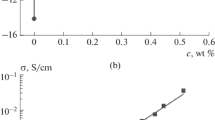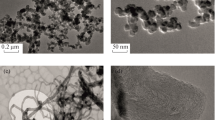Abstract
The dielectric properties of epoxy/short carbon fiber composites at different concentrations 0, 5, 10 and 15% by weight, different thicknesses 2 and 4 mm, and frequency in the range from 20 Hz to 1 MHz were characterized. Scanning electron microscopy and differential scanning calorimetry were utilized. The alternating current (ac) electrical properties (complex impedance, dielectric constant, dielectric loss, real part of electric modulus, imaginary part of electric modulus, electrical conductivity, and relaxation time) were determined. It was found that the applied frequency, filler concentrations, and composite thickness affected the ac electrical properties of the epoxy/carbon fiber composites. The dielectric behaviors of the interfacial polarization between epoxy matrix and carbon fibers could be described by the Maxwell–Wagner–Sillars relaxation. The analysis of the complex electric modulus in the frequency range from 20 Hz to 1 MHz revealed that the interfacial relaxation followed the Cole–Davidson distribution of relaxation times. The universal power-law of ac conductivity was observed in the epoxy/carbon fiber composites. The calculated power exponent (near unity) is physically acceptable within this applied model.










Similar content being viewed by others
References
Navin C, Deepak J (2004) Bull Mater Sci 27:227
Delmonte J (1990) Metal/polymer composites. Van Nostrand Reinhold, New York
Neelakanta PS (1995) Handbook of electromagnetic materials. CRC Press, Boca Raton
Surendra K, Neeti S, Ray BC (2009) J Reinf Plast Compos 28:16
Anupama K, Paramjit S, Jyot I (2010) J Reinf Plast Compos 29:1038
Tsotra P, Friedrich K (2003) Compos A Appl Sci Manuf 34:75
Tse KW, Moyer CA, Arajs S (1981) Mater Sci Eng 49:41
Lei L, Yiping T, Haijun Z, Jianhua Z, Wenbin H (2008) J Mater Sci 43:974. doi:10.1007/s10853-007-2089-5
Donnet JB, Bansal RC, Wang MJ (1990) Carbon fibers, 3rd edn. Dekker, New York
Park SJ, Chou MS (2000) Carbon 38:1053
Chand S (2000) J Mater Sci 35:1303. doi:10.1023/A:1004780301489
Rozik NN, Asaad JN, Iskander BA, Abd-El-Messieh SL (2009) J Reinf Plast Compos 28:2817
Teh PL, Mariatti M, Akil HM, Yeoh CK, Seetharamu KN, Wagiman AN, Beh KS (2007) Mater Lett 61:2156
Ellis B (1993) Chemistry and technology of epoxy resins. Chapman and Hall, London
El-Tantawy F, Kamada K, Ohnabe H (2002) Mater Lett 57:242
Achour ME, Brosseau C, Carmona F (2008) J Appl Phys 103:094103
Christopher J, Christopher V (2000) Compos Sci Technol 60:315
Xiaojun W, Chung DD (1996) Smart Mater Struct 5:796
Singh V, Kulkarni AR, Rama Mohan TR (2003) J Appl Polym Sci 90:3602
Tsangaris GM, Psarras GC, Kontopoulos AJ (1991) J Non-Cryst Solids 1164:131
Elimat ZM, Zihlif AM, Ragosta G (2008) J Phys D Appl Phys 41:165408
Soares BG, Leyva ME, Barra GM, Khastgir D (2006) Eur Polym J 42(3):676
Abd-El-Messieh SL, Abd-El-Nour KN (2003) J Appl Polym Sci 88:1613
Ying X, Yuezhen B, Chiang CK, Masaru M (2007) Carbon 45:1302
Macedo PB, Moynihan CT, Bose R (1972) Phys Chem Glasses 13(2):171
Tsangaris GM, Psarras GC, Kouloumbi N (1998) J Mater Sci 33(8):2027. doi:10.1023/A:1004398514901
Ben AI, Rekik H, Kaddami H, Raihane M, Arous M, Kallel A (2009) J Electrostat 67:717
Psarras GC, Manolkaki E, Tsangaris GM (2002) Compos A Appl Sci Manuf 33:375
Jonscher AK (1983) Dielectric relaxation in solids. Chelsea Dielectric Press, London, UK
Prabakar K, Narayansass SK, Mangalaraj D (2002) Cryst Res Technol 37:1094
Ayad A, Saq’an S, Ramadin Y, Zihlif A (2006) J Thermoplast Compos Mater 19:531
Acknowledgements
The authors would like to thank the DFG (German Research Foundation) for financial support under Schu 926 18-1, and also thanks to the Institute of Polymers and Composites at Technische Universität Hamburg-Harburg, Germany, for cooperation and technical support.
Author information
Authors and Affiliations
Corresponding author
Rights and permissions
About this article
Cite this article
Elimat, Z.M., Hamideen, M.S., Schulte, K.I. et al. Dielectric properties of epoxy/short carbon fiber composites. J Mater Sci 45, 5196–5203 (2010). https://doi.org/10.1007/s10853-010-4557-6
Received:
Accepted:
Published:
Issue Date:
DOI: https://doi.org/10.1007/s10853-010-4557-6




